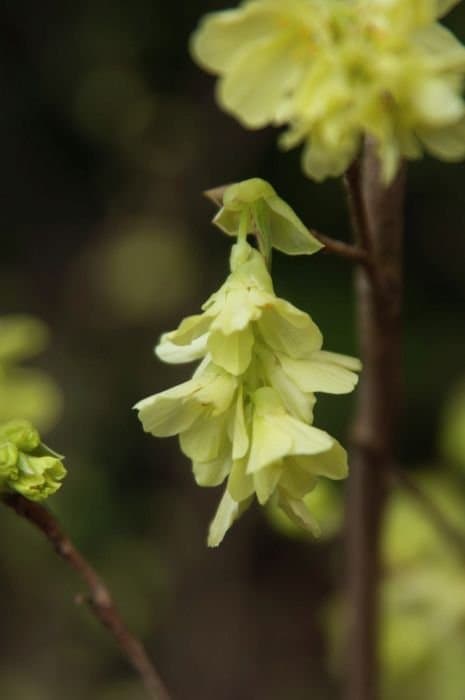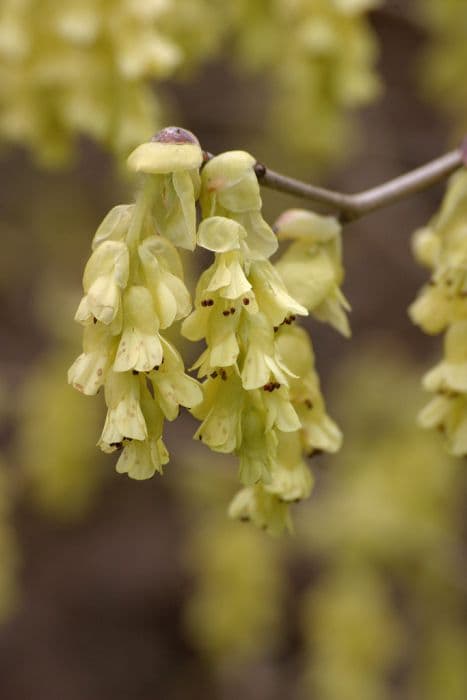Witch Hazel Hamamelis × intermedia 'John'

ABOUT
The plant known as 'John' is a hybrid witch hazel that showcases an array of attractive features and is especially noted for its striking flowers. These blossoms are unique, with long, ribbon-like petals that curl and twist, creating a frilly appearance. The flowers bloom in the winter to early spring, offering a vibrant splash of color when few other plants are in bloom. Typically, the flowers boast a bright yellow hue, though some may have an orange cast, adding warmth and contrast to the bleak winter landscape. Aside from its beautiful flowers, hybrid witch hazel exhibits a shapely form, with well-branched stems that create an overall rounded and full silhouette. The plant provides a lush background of foliage throughout the growing season. Its leaves are oval to broadly lance-shaped, with smooth or slightly wavy margins. In the fall, the foliage undergoes a dramatic transformation, turning from a deep green to a spectacular display of yellows, oranges, and reds, providing multi-seasonal interest. Without going into specific measurements, the overall presence of hybrid witch hazel 'John' is one of substantial beauty, making it a valuable addition to gardens for its winter blooms, attractive foliage, and colorful autumn display.
About this plant
 Names
NamesFamily
Hamamelidaceae
Synonyms
Witch Hazel, Hybrid Witch Hazel, Winterbloom
Common names
Hamamelis × intermedia 'John'.
 Toxicity
ToxicityTo humans
Witch hazel is generally considered non-toxic to humans. The plant, including the Hamamelis × intermedia 'John' variety, does not contain any known toxic substances that would cause poisoning when touched or ingested in typical small quantities. However, as with any plant, individuals may have allergies or sensitivities that could cause mild irritation or an allergic reaction. Ingesting large quantities of any non-food plant, including witch hazel, could potentially cause stomach upset or discomfort.
To pets
Witch hazel is generally considered non-toxic to pets. There is no widespread evidence to suggest that Hamamelis × intermedia 'John' or any other variety of witch hazel is poisonous to animals. While it's not a common food source, if a pet were to ingest a small amount of witch hazel, it is unlikely to suffer any significant adverse effects. As with any non-food plant, ingestion in significant quantities could potentially cause mild gastrointestinal upset such as vomiting or diarrhea in pets. Owners should monitor their pets to ensure they are not consuming large amounts of any non-food plants.
 Characteristics
CharacteristicsLife cycle
Perennials
Foliage type
Deciduous
Color of leaves
Green
Flower color
Yellow
Height
10-15 feet (3-4.5 meters)
Spread
10-15 feet (3-4.5 meters)
Plant type
Shrub
Hardiness zones
5-8
Native area
Japan China
Benefits
 General Benefits
General Benefits- Attractive Flowers: Produces vibrant yellow to orange-red flowers in late winter when few other plants are in bloom, providing color and visual interest.
- Winter Interest: Its blooming period during the winter months makes it valuable for adding aesthetic appeal to otherwise dormant landscapes.
- Fragrance: The flowers give off a pleasant fragrance, which can be enjoyed outdoors or when cut and brought inside the house.
- Attracts Wildlife: Provides food for pollinators during a time of year when few other nectar sources are available.
- Low Maintenance: Once established, it requires minimal care, making it suitable for gardeners of all skill levels.
- Adaptable: Grows well in various soil types, though it prefers well-drained, fertile soil, and can adapt to different pH levels.
- Tolerance: Exhibits good tolerance to cold temperatures, making it suitable for a variety of climates.
- Year-Round Interest: In addition to its flowers, it has attractive foliage in the spring and summer and can demonstrate appealing fall colors.
 Medical Properties
Medical PropertiesThis plant is not used for medical purposes.
 Air-purifying Qualities
Air-purifying QualitiesThis plant is not specifically known for air purifying qualities.
 Other Uses
Other Uses- Witch hazel branches can be used in floral arrangements both for their unique curving shapes and winter bloom, providing an aesthetic appeal to indoor spaces.
- The plant can serve as a natural pest deterrent when strategically planted in gardens because some pests dislike its fragrance.
- Adding cut witch hazel to a bath can create a fragrant, soothing soak for relaxation, without the use of synthetic fragrances.
- Due to its early flowering period, witch hazel can be used as an indicator plant to signal the impending arrival of spring.
- The distinctive witch hazel flowers can be used in crafting, such as to make natural potpourri with a unique appearance.
- The leaves of the witch hazel can be pressed and included in nature-inspired art projects and educational leaf collections.
- Witch hazel branches are sometimes used in the practice of dowsing or water divining, though it's a practice not based on scientific evidence.
- The dense structure of witch hazel can provide nesting sites and cover for local bird species in a garden setting.
- Fall foliage of witch hazel, with vibrant yellow to red leaves, can contribute to autumn landscape photography and painting.
- Collecting and floating witch hazel’s distinctive ribbon-like petals in bowls of water can create a visually interesting centerpiece for tables.
Interesting Facts
 Feng Shui
Feng ShuiThe Witch Hazel is not used in Feng Shui practice.
 Zodiac Sign Compitability
Zodiac Sign CompitabilityThe Witch Hazel is not used in astrology practice.
 Plant Symbolism
Plant Symbolism- New Beginnings: As a variety of witch hazel that blooms in late winter, Hamamelis × intermedia 'Jelena', often called witch hazel, symbolizes new beginnings and the hope that comes with the start of a new season.
- Healing: Witch hazel has long been used for its medicinal properties. It symbolizes healing and is often associated with nature's power to rejuvenate and restore health.
- Protection: With its strong, aromatic presence, witch hazel is also thought to offer protection. It is said to guard against negative influences and to provide a safe space for growth.
- Adaptability: The ability of witch hazel to bloom in the coldest part of the year suggests qualities of resilience and adaptability, embodying the spirit to thrive even in challenging conditions.
 Water
WaterWitch Hazel 'John' should be watered deeply and thoroughly to establish a strong root system, which may mean about 1 to 1.5 gallons per week, depending on climate and soil conditions. It's preferable to water this plant once a week with a generous amount rather than frequent, shallow waterings. During hot and dry spells, increase the frequency to twice a week. Always check the soil moisture by feeling it a few inches deep; if it's dry, it's time to water. In winter, you may need to water less frequently, just enough to prevent the soil from completely drying out.
 Light
LightWitch Hazel 'John' thrives in full sun to partial shade. Ideally, it should receive at least 4 to 6 hours of direct sunlight per day but can benefit from some afternoon shade in hotter regions to protect it from excessive heat. An eastern or western exposure with dappled light would be optimal, ensuring it receives enough light for healthy growth and abundant flowering.
 Temperature
TemperatureWitch Hazel 'John' is a hardy plant that can tolerate a wide range of temperatures, typically from -10 to 120 degrees Fahrenheit. The ideal growing temperature for Witch Hazel is between 60 and 75 degrees Fahrenheit. It is important to protect the plant from extreme heat by providing afternoon shade, and in colder climates, a layer of mulch can help insulate the roots from severe cold.
 Pruning
PruningWitch Hazel 'John' should be pruned to remove any dead or crossing branches and to maintain its shape. The best time for pruning is in the late winter or early spring, just after it finishes flowering but before new growth starts. Pruning once a year is usually sufficient to keep the plant healthy and looking its best.
 Cleaning
CleaningAs needed
 Soil
SoilWitch Hazel 'John' prefers well-drained soil enriched with organic matter. A balanced mix of loam, peat, and perlite or pine bark enhances drainage and aeration. Aim for a soil pH of 5.5 to 6.5 for optimal growth.
 Repotting
RepottingWitch Hazel 'John' is a large shrub and does not require frequent repotting. It is typically planted directly in the garden and may only need transplanting if it outgrows its space or for garden redesign.
 Humidity & Misting
Humidity & MistingWitch Hazel 'John' tolerates a range of humidity levels but performs best with moderate ambient humidity. It does not require any special humidity adjustments when planted outdoors in its natural environment.
 Suitable locations
Suitable locationsIndoor
Witch Hazel 'John' unsuitable for indoor growth; prefers outdoor conditions.
Outdoor
Position Witch Hazel 'John' in sun to partial shade, ensure moist, well-drained soil.
Hardiness zone
5-9 USDA
 Life cycle
Life cycleWitch Hazel 'John' begins its life cycle as a seed, which after stratification germinates in spring. The seedling stage is characterized by the initial development of leaves and a root system. As it enters the vegetative stage, the plant develops a woody structure and foliage, forming a multi-stemmed shrub. During the reproductive stage, typically in late winter, Witch Hazel 'John' produces fragrant yellow flowers with crinkled petals before the emergence of leaves. Following pollination by insects, the plant sets seed contained in capsules that mature in fall and forcibly eject seeds, completing the cycle. The mature plant can also spread asexually through root suckers, contributing to its expansion and longevity.
 Propogation
PropogationPropogation time
Late winter
The most popular method of propagating Hamamelis × intermedia 'Jelena', commonly known as Witch Hazel, is through softwood cuttings. This technique is typically performed in late spring to early summer when new growth is still flexible but mature enough to endure the propagation process. Carefully selected branch tips about 4 to 6 inches (approximately 10 to 15 cm) long are cut and the leaves on the lower portion of the cutting are removed. To promote root growth, the base of each cutting is then dipped in a rooting hormone before being planted in a well-draining rooting medium. The cuttings are usually kept under high humidity conditions, such as under a mist system or plastic cover, to prevent them from drying out during the rooting period which can take several weeks. Regular monitoring ensures that the cuttings do not rot or succumb to fungal infections.









